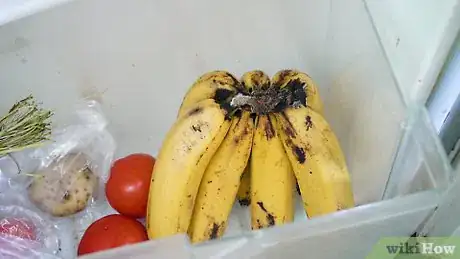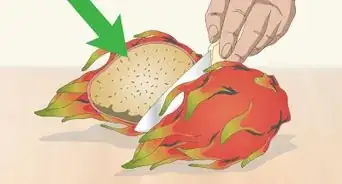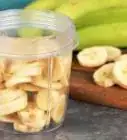wikiHow is a “wiki,” similar to Wikipedia, which means that many of our articles are co-written by multiple authors. To create this article, 31 people, some anonymous, worked to edit and improve it over time.
There are 8 references cited in this article, which can be found at the bottom of the page.
The wikiHow Culinary Team also followed the article's instructions and verified that they work.
This article has been viewed 1,116,559 times.
Learn more...
Available year round, portable, sweet and creamy, bananas are a convenient way to add key nutrients to your diet. Bananas are high in vitamins, potassium, soluble fiber and protease inhibitors, which help remove stomach bacteria. Studies have found that regularly eating bananas helps maintain heart function, blood pressure levels, bone density, vision, digestion and kidney health. Buy bananas fresh and store them for future use.
Steps
Storing to Ripen
-
1Choose bananas based on their degree of ripeness. Depending on when you want to use them and how you wish to store them, you may want them to be more or less ripe. If you're shopping just for yourself, then you may want greener bananas so they aren't all ripe right away. If you're shopping for a family or a few people who will eat them quickly, then ripe bananas are the way to go. Here are some things to keep in mind when choosing your bananas:
- Green bananas are not ripe yet. Buy green bananas for maximum storage life without freezing. Choose firm fruit without dark spots or abrasions on the peel.
- Ripe bananas have turned their adult color. Most bananas are yellow when ripe, but some varieties are brown or red. The more the banana's adult color appears on the peel, the riper it is.
- Brown-spotted bananas are the sweetest. As the small brown spots grow on the peel, the fruit inside ripens even further. When the peel shows more brown or black than yellow, the fruit is over-ripe.
- Avoid bananas that have a gray tint and look dull in color. This is a sign that the bananas were refrigerated, which interferes with proper ripening.
-
2Remove bananas from plastic produce bags as soon as you get them home. Never store bananas in plastic bags, which hold too much moisture and could cause the fruit to rot.
- There is an alternative theory. The bananas may remain fresh longer inside the bag; take one out and leave the rest in the bag to test this. If the one that is removed ripens faster, then the bag may prove capable of retaining freshness. However, this may depend on the humidity and heat levels in the room where you're storing the bananas.
Advertisement -
3Store green bananas at room temperature. Refrigerating or freezing bananas before they ripen prevents the fruit from being able to properly ripen even after brought back to room temperature.
- Put green bananas into a brown paper bag to speed up the ripening process. Add an apple or a tomato to the bag to ripen the bananas in less than 1 day.
- Another way to speed up the ripening process is to place the bananas near other ripe fruit in a bowl, such as other ripe bananas.
-
4Leave yellow-green ripening bananas exposed to air at room temperature for a few days. Be patient. Though it's true that the warmer the room, the sooner they will ripen, you should avoid placing the bananas in direct sunlight.
-
5Hang the bananas on a banana tree. If you're a true banana lover, then a banana tree is a great investment. You can find free-standing banana trees that you can place on your countertop, as well as mountable banana hangers. Banana trees and hangers allow air to circulate and avoid "resting bruises" on the fruit.
-
6Keep ripe bananas at room temperature if you will be eating them within a few days. Eat or refrigerate the bananas as spots develop on the skin and before they are overripe.
-
7Keep sliced bananas fresh. If you've sliced a banana, whether it's to put it in the fridge or to make a delicious fruit salad, you should cover the slices in a bit of lemon juice, pineapple juice, or vinegar, all of which will keep it fresher for longer.[1]
Storing Ripe Bananas
-
1Pull the bananas apart from the bunch. If your bananas are already pretty ripe, then you can keep them fresh and yellow for longer by pulling each banana away from the bunch. This will keep each banana fresher for longer.
-
2Store the ripe bananas with unripe fruit. Take an unripe pear or avocado and place it near the bananas, and it will slow down the ripening process of the bananas, while ripening faster itself. It's a win-win situation!
-
3Wrap the stems of the bananas in plastic wrap. This will prevent ethylene gas, which is produced naturally during the ripening process, from reaching other parts of the fruit and making it ripen too fast. You can even place some tape over the plastic wrap for some extra security. Every time you remove a banana from the bunch, rewrap it carefully. Alternately, you can just separate the bananas from the bunch and then wrap the stem of each one individually. This takes a bit of love, but it's worth it![2] [3]
-
4Put the bananas in the produce drawer of your refrigerator after they are fully ripe. Refrigeration slows the ripening process considerably, but does not stop it. The peel will continue to turn brown, but the fruit will stay fresh and firm for 1 to 2 weeks. According to Dole Bananas, storing ripe bananas in the refrigerator will preserve their delicious taste for longer, even though their peels may turn black.[4]
-
5Peel the bananas before freezing them. Put as many as will fit into a zipper storage bag or plastic container and store in the freezer. Note: Freezing bananas in their peel will make it impossible to peel them if frozen. And once they thaw, they turn into a goopy mess. Add frozen, peeled bananas to smoothies.
-
6Store bananas in the freezer for several months. When thawed, you can use the bananas to bake and cook, as well as in fruit sauces and smoothies. You can also drizzle them with just a bit of lemon juice to keep them from turning brown.[5]
- Peel bananas and cut them into chunks or mash them before freezing.
- Portion the banana into the amounts you need to make a recipe.
- Put portioned bananas into zipper freezer bags or plastic containers and store them in the freezer.
-
7Make banana bread with overripe bananas. Banana bread is a delicious treat that is designed to be made with overripe bananas. If it's too late for you to store them and eat them enjoyably, then it may be time to make this delicious treat. After all, you don't really want to waste what was once a tasty bunch of bananas, do you? All you need is a few simple ingredients, which include bananas, nuts, flour, eggs, butter, and cinnamon.
Community Q&A
-
QuestionIs it OK to eat an overripe banana?
 wikiHow Staff EditorThis answer was written by one of our trained team of researchers who validated it for accuracy and comprehensiveness.
wikiHow Staff EditorThis answer was written by one of our trained team of researchers who validated it for accuracy and comprehensiveness.
Staff Answer wikiHow Staff EditorStaff AnswerOverripe bananas are safe to eat. The real issue is your preference; when a banana is at its best for eating is a subjective decision and some people love overripe bananas, others find them too mushy and sweet. Try it to see if you like it. Do not any banana showing signs of mold or deterioration though; if in doubt, compost it. Another great use for overripe bananas is to bake them into a cake, muffins or cookies.
wikiHow Staff EditorStaff AnswerOverripe bananas are safe to eat. The real issue is your preference; when a banana is at its best for eating is a subjective decision and some people love overripe bananas, others find them too mushy and sweet. Try it to see if you like it. Do not any banana showing signs of mold or deterioration though; if in doubt, compost it. Another great use for overripe bananas is to bake them into a cake, muffins or cookies. -
QuestionHow to keep bananas from turning dark in banana pudding?
 wikiHow Staff EditorThis answer was written by one of our trained team of researchers who validated it for accuracy and comprehensiveness.
wikiHow Staff EditorThis answer was written by one of our trained team of researchers who validated it for accuracy and comprehensiveness.
Staff Answer wikiHow Staff EditorStaff AnswerTry sprinkling the cut banana pieces with lemon juice before using in the pudding. Be sure to use the cut bananas immediately, by coating them in the custard or pudding mixture to prevent air accessing them and causing the browning via oxidation. Another trick is to assemble the pudding just before serving, so there isn't enough time for the browning to occur. However, if the bananas do turn brown, it's still completely safe to eat, just not as pretty.
wikiHow Staff EditorStaff AnswerTry sprinkling the cut banana pieces with lemon juice before using in the pudding. Be sure to use the cut bananas immediately, by coating them in the custard or pudding mixture to prevent air accessing them and causing the browning via oxidation. Another trick is to assemble the pudding just before serving, so there isn't enough time for the browning to occur. However, if the bananas do turn brown, it's still completely safe to eat, just not as pretty. -
QuestionHow can I stop bananas browning in the refrigerator?
 wikiHow Staff EditorThis answer was written by one of our trained team of researchers who validated it for accuracy and comprehensiveness.
wikiHow Staff EditorThis answer was written by one of our trained team of researchers who validated it for accuracy and comprehensiveness.
Staff Answer wikiHow Staff EditorStaff AnswerBefore refrigerating, bananas should be at the level of ripeness you want them to be. To prevent browning, wrap the bananas individually in newspaper or butcher's paper. Place the wrapped bananas in the refrigerator for up to 2 weeks, and they should be still yellow and the flesh will be just fine.
wikiHow Staff EditorStaff AnswerBefore refrigerating, bananas should be at the level of ripeness you want them to be. To prevent browning, wrap the bananas individually in newspaper or butcher's paper. Place the wrapped bananas in the refrigerator for up to 2 weeks, and they should be still yellow and the flesh will be just fine.
Warnings
- Bananas left at room temperature may draw fruit flies. Store the bananas in a sealed paper bag or in the refrigerator if fruit flies are a problem.⧼thumbs_response⧽
References
- ↑ http://www.instructables.com/id/Keep-Bananas-Fresh-Longer-slices-too/step1/Preserve-the-Bunch-Wrap-Stems-with-Plastic-Wrap/
- ↑ http://lifehacker.com/5967424/keep-bananas-fresh-longer-by-separating-them-and-wrapping-the-stems-in-plastic-wrap
- ↑ http://www.phillymag.com/be-well-philly/2013/07/23/bananas-turning-brown/
- ↑ http://www.dole.com/Products/Fresh-Fruits/Bananas
- ↑ http://www.dole.com/Products/Fresh-Fruits/Bananas
- http://whfoods.org/genpage.php?tname=foodspice&dbid=7 – research source
- http://amarillo.com/lifestyle/advice/2011-04-27/heloise-store-bananas-save-money – research source
- https://www.frugalvillage.com/threads/best-way-to-store-bananas.248122/ – research source
- http://ths.gardenweb.com/forums/load/cooking/msg0921175426992.html – research source
About This Article
To store bananas, first separate them from the bunch. Then, slow down the ripening process by wrapping the stem of each banana with plastic wrap. Wrapping the stems will slow down the release of Ethylene, a gas that causes fruit to ripen quickly. Next, place the bananas in the fridge, away from other fruits and vegetables. Store them for 1-2 weeks. To store bananas for even longer, first peel the bananas. Then, slice the bananas into 1-2 inch pieces and place them on a baking sheet lined with parchment paper. Place them in the freezer for 2 hours. Next, transfer the frozen slices into a resealable bag or container, and store for up to 6 months. Try your frozen bananas in smoothies or baking! If you want to learn how to freeze bananas to use them later, keep reading the article!



























































